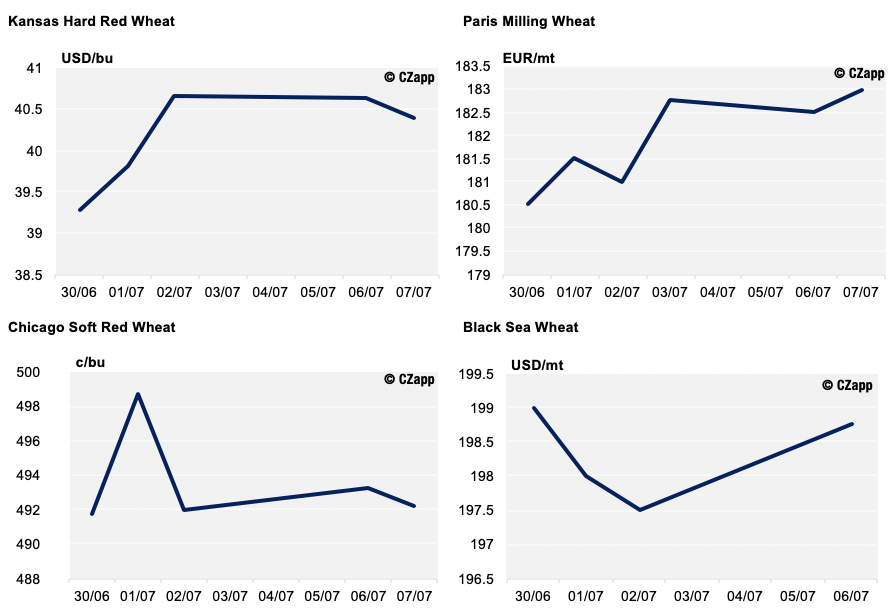- The US’ harvest is over half-way done, and it’s picking up in Europe.
- We continue to keep an eye on Argentina and Australia.
- We wait with anticipation for the USDA’s July WASDE report coming on Friday.
The Key Markets Last Week
The last 10 days have seen the wheat markets rally slightly in Europe and the Black Sea region. However, the US markets have traded up and down a little, but there has not been a great change in the underlying price.

As we reach the halfway point in the US harvest, and it begins in Europe and the Black Sea, the coming weeks will help steer the market.
With the funds short of wheat in the US, there’s an opportunity for a rally, but having read a report suggesting that Hard Red Wheat FOB prices are US$12/mt more expensive than Russian, there will no doubt be some resistance following any move upwards.
Egypt’s wheat tender today, will give some insight into the price picture over the coming days.
The Harvest Progresses in the Northern Hemisphere
Yesterday’s weekly progress report from the USDA put the winter wheat harvest in the US up from 41% last week to 56% complete, comfortably above last year’s 42%.
The Hard Red Wheat crop has been variable, but the quality is looking ok and yields are as expected overall. Soft Red Wheat is seeing pretty good quality, with yields in line with pre-harvest thoughts.
Western Europe is seeing the harvest rumble northwards into Southern France, where the harvest is at 4% completion.
The Black Sea area has started to see wheat hit the stores. In Southern Russia, yields look disappointing. This is no great surprise given the warm and dry winter, followed by less rain than desired in the spring. There will likely be better areas as the harvest progresses, but it looks like export availability will reduce from the new harvest in the short-term.
As previously mentioned, production reports are generally poor for North Africa, resulting in a potential need for increased imports over the coming months, most likely from Europe and the Black Sea.
The world’s two largest countries by population and wheat stocks, China and India, continue to report encouraging crop sizes. Any excess will no doubt just increase their already large stocks.
Argentina and Australia
It has been interesting reading reports over recent months as both Argentina and Australia have seen good rains ahead of planting, as well as some impressively high crop estimates for harvest at the end of 2020.
The last couple of weeks have seen more concern for dry areas in Argentina. The last two months have had only 20% of normal rainfall in parts, reducing the overall planted area. The Buenos Aires Grain Exchange has, this week, cut their wheat plantings estimate from 6.7mha to 6.5mha, with approximately 80% planted thus far.
Australia has, on the whole, seen healthy plantings after the excellent rains in early 2020. It is still a long way to go until harvest and less encouraging are the farmers looking for more rain, as we see in Queensland where the forecast over the next two weeks is diminishing amounts of precipitation.
What’s on the Horizon?
With harvests trekking on in the Northern Hemisphere, we will get a better understanding of supply over the coming weeks. Any yield shortfall from estimates in Europe or the Black Sea could set off a few fireworks.
A continuation of the dry weather in the Southern Hemisphere and the 21mmt record Argentinian or enormous 26mmt Australian wheat crops predicted may well not materialise.
On the flip side, we wait with anticipation for the USDA’s July WASDE Report due this Friday. The last few months have painted a picture of ample global wheat stocks, keeping a lid on any market rally.
The next week will be interesting but, as always, the weather’s influence on the current harvests and growing crops will have the final say in where we are heading!







